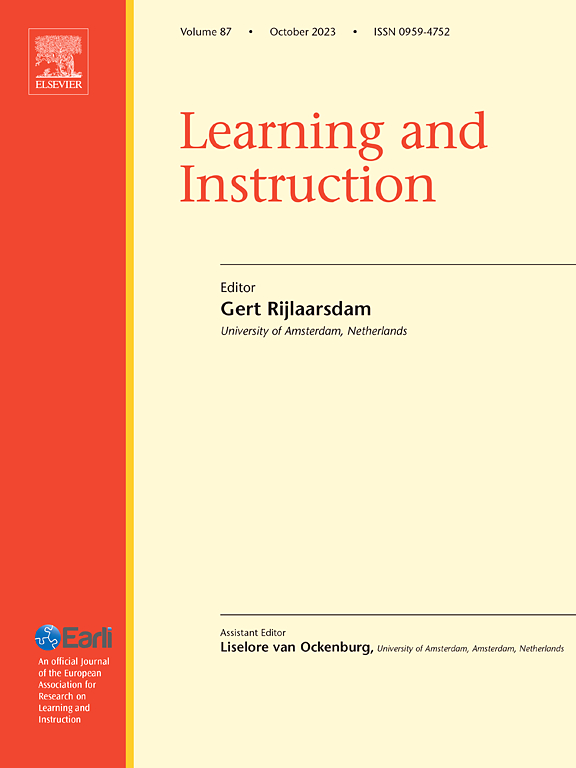诱惑性细节在外因动机低和外因动机高的学习环境中的影响
IF 4.9
1区 教育学
Q1 EDUCATION & EDUCATIONAL RESEARCH
引用次数: 0
摘要
背景在学习环境中加入有趣但无关的元素(诱人的细节)可以提高学生的学习积极性,但同时也会增加无关的认知负担。因此,研究主要表明这会对学习产生不利影响。我们假设,当外在学习动机较高时,诱导性细节会损害学习效果,但当外在学习动机较低时,诱导性细节会改善学习效果,因为通过诱导性细节可以挖掘的学习动机潜力更大,因此,学习动机的益处可能会大于认知方面的弊端。诱导性细节的存在在受试者之间进行操控(有诱导性细节与无诱导性细节)。作为外在动机的一种,外部调控通过将相应的学习单元引入自愿或强制的方式,在受试者内部进行操控(低与高)。结果两项实验的结果表明,诱人细节的出现只会影响高外部调控单元的测试成绩,而对低外部调控单元则没有影响,甚至会提高学习成绩。此外,在这两项研究中,诱导性细节只在低外部调节单元中通过兴趣间接提高了测试成绩。结论结果强调,不应将诱导性细节本身视为不利因素,而应将其视为动机优势和认知劣势之间的权衡。因此,诱导性细节是阻碍学习还是促进学习在很大程度上取决于学习者事前的动机程度。本文章由计算机程序翻译,如有差异,请以英文原文为准。
The influence of seductive details in learning environments with low and high extrinsic motivation
Background
The inclusion of interesting but irrelevant elements (seductive details) in learning environments can increase students’ motivation but also extraneous cognitive load. Accordingly, research mainly suggests detrimental effects on learning. However, most studies were conducted with participants who were extrinsically motivated to engage with the learning material anyway.
Aims
We assumed that presenting seductive details would impair learning when extrinsic motivation is high but improve learning when extrinsic motivation is low because the motivational potential that could be exploited through seductive details is greater and, thus, the motivational benefits might outweigh the cognitive disadvantages.
Sample and method
Two experimental studies (N = 120; N = 210) were conducted, which followed a 2 × 2 mixed design. The presence of seductive details was manipulated between subjects (with vs. without). External regulation - as one type of extrinsic motivation - was manipulated within subjects (low vs. high) by introducing the respective learning unit as either voluntary or mandatory.
Results
Results of both experiments showed that presenting seductive details only impaired test performance in high external regulation units but had no effect or even improved learning in low external regulation units. Additionally, in both studies, seductive details indirectly improved test performance via interest only in low external regulation units.
Conclusions
The results emphasize that the inclusion of seductive details should not be seen as unfavorable per se but as a trade-off between motivational advantages and cognitive disadvantages. Hence, whether seductive details impede or promote learning considerably depends on how much learners are motivated beforehand.
求助全文
通过发布文献求助,成功后即可免费获取论文全文。
去求助
来源期刊

Learning and Instruction
Multiple-
CiteScore
11.30
自引率
4.80%
发文量
109
期刊介绍:
As an international, multi-disciplinary, peer-refereed journal, Learning and Instruction provides a platform for the publication of the most advanced scientific research in the areas of learning, development, instruction and teaching. The journal welcomes original empirical investigations. The papers may represent a variety of theoretical perspectives and different methodological approaches. They may refer to any age level, from infants to adults and to a diversity of learning and instructional settings, from laboratory experiments to field studies. The major criteria in the review and the selection process concern the significance of the contribution to the area of learning and instruction, and the rigor of the study.
 求助内容:
求助内容: 应助结果提醒方式:
应助结果提醒方式:


